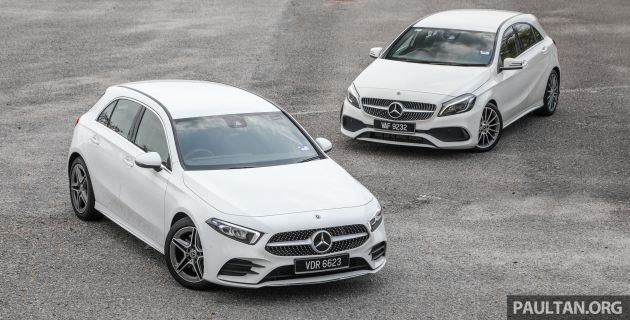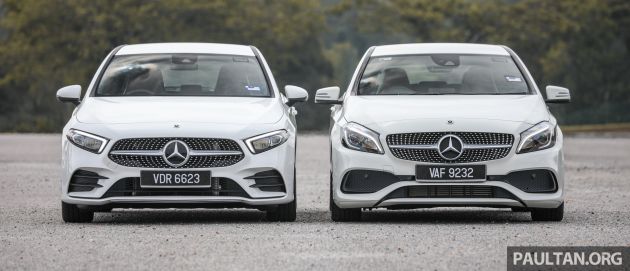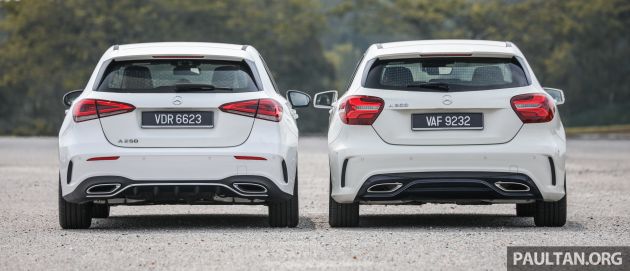Side by side comparisons are a good way to spot the changes between model generations, and we’re doing just that with the Mercedes-Benz A-Class. Most of you are familiar with the compact model in its third generation (W176), which marked a radical departure from the boxy look of the first two generations (W168 and W169).
More dynamic in appearance and appealing massively to younger customers, the W176 was a popular choice among those looking to get into Mercedes-Benz ownership. It would then be replaced with the fourth-generation A-Class (W177) in February 2018, which was launched in Malaysia the same year later on in October.
Still retaining its sleek, hatchback body style, the W177 showcased the brand’s latest design language with a more aggressive front end clearly inspired by the latest C257 CLS. This includes slimmer and more angular headlamps that flank a trapezoidal grille, the latter with a diamond pin insert on AMG Line-equipped models like the W177 A 250 we have here.
The previous W176 A 200 AMG Line beside it also sports a diamond pin grille, but as you can see, its lower apron is visibly different from the W177. While the newer model has a bumper design that mimics the larger AMG-styled sedan models (think C 43 and the C 300 AMG Line) with fins on the corner “inlets,” the W176 does without them.
More hints of the CLS can be seen at the rear of the W177 with the two-piece taillights, which take up considerably less space than the larger (and more squarish) clusters on the W176. The rear bumper continues to feature two exhaust outlets, but the newer A-Class has a more expressive diffuser-like element by comparison.
Built on the uprated Modular Front Architecture 2 (MFA2) platform, the W177 is now 4,419 mm long, 1,796 mm wide and 1,440 mm tall, making it a whopping 127 mm longer, 16 mm wider and 7 mm taller than before; its wheelbase is also 30 mm longer, at 2,729 mm. Mercedes claims that the car now offers greater head-, shoulder- and elbow room, easier rear-seat access and a boot that is 29 litres larger at 370 litres.
The changes on the inside are just as noticeable, with the W177’s dashboard being dominated by a pair of 10.25-inch displays to handle instrumentation and infotainment. The central display also comes with touchscreen support unlike on the W176 that requires you to use the rotary control knob on the centre console.
On the mention of controls, the W177’s infotainment can be also be accessed by the touch-sensitive controls on the redesigned steering wheel in addition to the touchscreen and touchpad – the latter is in line with models higher up the Mercedes-Benz range. Voice commands continue to be offered as well, but is further improved in the W177 thanks to the Mercedes-Benz User Experience (MBUX) system.
More intuitive than the Audio 20 system it replaces, the newer MBUX comes with added functionality, including a more natural voice recognition system that can be triggered via the activation phrase “Hey Mercedes.”
As for the rest of the cabin, the W177 continues to retain the air vent arrangement of its predecessor, with three circular vents in the centre, while the ones in the corner are positioned slightly higher. The archaic climate controls have also been updated to toggle switches, which again, brings the A-Class closer to its more upmarket siblings.


Under the bonnet, the W177 A-Class is offered with a choice of a M282 1.33 litre four-cylinder turbocharged petrol engine developed in conjunction with Renault. The mill, which is found in the base A 200 Progressive Line, makes 163 hp and 250 Nm of torque, with a Getrag seven-speed wet dual clutch transmission paired to it. The A 250 AMG Line you see here gets a revised M260 2.0 litre unit that churns out 224 hp and 350 Nm, mated to Mercedes’ own DCT, which is also a wet clutch unit.
Meanwhile, the W176 A-Class in its last, facelift form sold in the past, was available in three variants – A 180 Urban Line, A 200 AMG Line and A 250 Sport. Both the A 180 and A 200 (seen here) came with a M270 1.6 litre turbo four-pot, which served up 122 hp and 200 Nm in the A 180, and 156 hp and 250 Nm in the A 200. The A 250 used a 2.0 litre version of the M270 with 211 hp and 350 Nm – all three used a 7G-DCT seven-speed dual-clutch automatic transmission.
After you’ve digested these details, spend some time to browse through our photos of the two A-Class generations placed side by side, and let us know which one is more appealing to you in the comments below. All opinions are welcomed, even if you’re a fan of the W168 or W169.
Source: Read Full Article



